GROWTH
It is a process that starts in the womb after fertilization and continues until adulthood.
☆ The increase in body volume and mass is the regular increase in the measurement values of the body and organs in this process, which starts from the mother’s womb and continues until the end of the adult period.
☆The fastest is intrauterine life, the first 2 years after birth and adolescence years.
☆The slowest; 3-4 years old and 9-10 years old.
DEVELOPMENT
☆ It expresses the functional changes of the individual. It is a result of biological, cultural and individual factors together.
☆ Development cannot be achieved without maturation and learning. (Growth 》 Maturation 》 Learning)
☆In order for the child to function at a high level, ability must emerge and progress.
Example: Crawling.
MATURATION
☆It is the development that enables the individual to reach the level of maturity as a result of the interaction between heredity and environmental conditions and determines the order
of development.
PLASTICITY
☆ Behaviors exhibited by most of the non-human beings are biologically programmed, that is, they are instinctive behaviors that are not learned. Since these instinctive behaviors that humans are born with are almost non-existent, people have to learn a number of information throughout their lives.
MOTOR LEARNING
It refers to the progress in the performance acquired depending on the learning of the movement through experience.
REFLEX MOVEMENT PERIOD
☆ It is the first movement of fetus and newborn.(such as catching, stepping)
☆Reflex movements are seen in newborns rather than voluntary movements and it enables the baby to obtain information for the first time.
☆ Newborn behavior is controlled by the subcortical center (lower brain). As the Cerebral Cortex matures, voluntary movements begin.
☆ These primitive reflexes, seen between the ages of 0-2, are the first form of voluntary movements in later times. Primitive movements depend on maturation and appear and disappear in a certain order.
☆Reflexes named below;
●The continuation of reflexes that should be absent or invisible.
●Unilateral vision of the reflex that should be seen bilaterally.
●In cases where the reflex is too strong or weak, it may be a sign of a neurological disorder. Also, some of the reflexes can be examined for diagnostic purposes. For example, the absence of the Moro reflex determines a cerebral birth injury. The asymmetric tonic neck reflex may indicate cerebral palsy or another neurological problem.
☆Reflex movements period consists of 2 phases;
1.Information Collection Phase
● It starts from the fetal period and continues until the 4th month of infancy.
●In this stage, the lower brain centers are more developed than the motor cortex.
- Reflexes help the baby gather information through movement, store it in the cortex, search for food and protect it. So they are important for survival.
2.Information Processing Phase
●It starts in the 4th month.
●As the upper brain centers continue to develop at this stage, reflexes gradually disappear.
●Reflex movements are replaced by voluntary movements regulated by the motor areas of the cerebral cortex.(such as sitting, crawling, catching-release)
☆Gallahue has divided newborn reflexes into two;
1.Primitive(primitive)reflexes》Prenatal life last 4 months+neonatal period first 4 months
2.Postural reflexes are similar to later volitional behaviors but are completely involuntary.
PRIMITIVE REFLEXES
1.Moro.
☆Prenatal (prenatal)-Postnatal is seen between 4-6 months.
☆ Loud noise, as a result of movements such as abruptly but gently lifting the baby’s head and releasing it, or holding it by both hands and gently lifting it and then dropping it to the ground. 》 The arms and legs go into extension, followed by a hug and then a return to the normal position.

2.Search
☆ It is seen 3 months before and after birth. It is together with the sucking reflex.
☆When you touch the cheek, searching for the stimulus and head movements towards the stimulus appear.
☆ When the middle of the lip is touched, the baby opens his mouth.

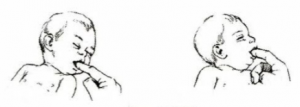
3.Suction
☆ It starts in the uterus and is seen 3 months after birth. It is usually together with the search reflex.
☆When the baby touches the lips, the baby starts to make a sucking motion.
4.Palmar Grip
☆ It is seen for 5 months before birth and 4 months after birth. It is one of the most important reflexes.
☆When the baby touches the palm, the fingers open, then the 4 fingers are closed except the thumb.
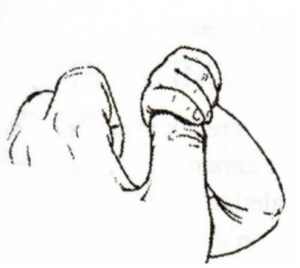
5.Plantar Grip
☆It is seen at birth and 1 year old. It should disappear before standing or walking in babies.
☆When a finger touches the sole of the baby’s feet, the grasping position is seen with the toes.
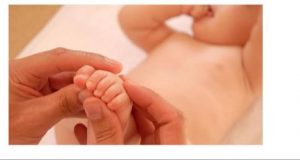
6.Babinski
☆Occurs during birth and 4 months after birth.
☆When the lateral and upper part of the baby’s foot is scratched with a finger 》 fingers open and thumb turns downward.

- Symmetrical Tonic Neck
☆It is seen for 3 months after birth.
☆When the baby’s head is tipped forward 》 While the neck and arms come to flexion, the legs come to extension.
☆ When the baby is seated and his head is tipped backwards 》 While the neck and arms come to extension, the legs come to flexion.8.Asymmetrical Tonic Neck
☆Occurs 6 weeks after birth (more prominent at this time) and 3 months.
☆ Baby’s head is turned to one side when prone or supine position 》 While the facial extremities come to extension, the extremities on the other side come to flexion.

POSTURAL REFLEXES
Crawling
☆ It is seen during the birth and postpartum 3-4 months. It is the harbinger of the next voluntary crawling movement.
☆The baby is placed face down and pressure is applied with the index finger of one hand 》 The arms and feet move in a crawling fashion.
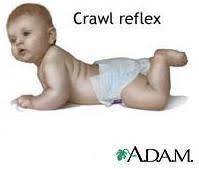
2.Step Take
☆ It is seen during 5-6 postpartum days. It is also called the walking reflex. It is already the main messenger of walking.
☆The baby stands upright with the help of one person, with the feet touching the ground. 》 At this time, the legs rise and fall.

3.Turning Head and Body
☆The head is seen for 1-6 months and the trunk for 4-6 months.
☆Baby lays in supine position with head turned to one side 》 The body also turns in the same direction.
☆Baby lies in supine position with hips and legs turned to one side 》 The body and head also turn in the same direction.
4.Parachute and Propping
☆Parachute response 4 months and 1 year; Propping is seen in the 6th month and the backward reactions are seen in the 10-12th months.
☆If the baby experiences a sudden fall in the upright position 》 stretches the legs to the sides and makes protective movements.

5.Landau(Ventral Suspension)
☆1.5 -4 months, the head and shoulders are at the same level; in 4-7 months, the head is lifted above the shoulder level and the legs are actively lifted.
☆The baby is laid face down and lifted in this position on one person’s side parallel to the floor. 》 Initially, only the head, back and legs are stretched, then the back becomes concave.
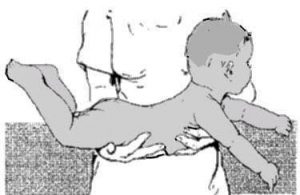
6.Labyrinth
☆It is seen between 2-3 months and 1 year. Sometimes it can be considered as a primitive reflex.
☆The baby is held upright and tilted in one direction with the help of one person 》 The baby tilts his head to the side in the opposite direction.
7.Traction
☆Occurs between 3 months and 1 year.
☆ With the help of a person, the baby is tried to be seated by holding the hands while in the supine position. 》 The baby tries to flex his arms and pull himself forward (towards the person holding his hands) to maintain the upright position.
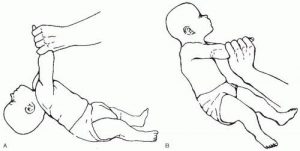

Leave a Reply